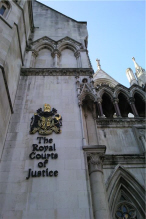Falls causing serious injury
- Details
 Following the judgment of the Court of Appeal in Edwards v Sutton London Borough Council the Courts have again considered the question of the duties of occupiers and highway authorities in relation to a fall causing serious injury. Lea Brocklebank and David Williams report.
Following the judgment of the Court of Appeal in Edwards v Sutton London Borough Council the Courts have again considered the question of the duties of occupiers and highway authorities in relation to a fall causing serious injury. Lea Brocklebank and David Williams report.
On 10 December 2011, Paul Singh slid down a steep slope into Llanishen Brook whilst walking home from a night out in Cardiff and suffered life changing injuries. He had been walking along a footpath that was a public highway for the purposes of the Highways Act 1980 and the adjacent land was also owned by the highway authority, City of Cardiff Council. The footpath was lined by broken and uneven edging units and had a depression which was about 60mm deep. In addition, one of the two streetlights in the vicinity was not working. The Court was required to consider whether the claimant's injuries were caused by a breach of the duties owed to him by the city council under the Highways Act 1980, the Occupiers' Liability Act 1957 and at Common Law.
In Singh v The City of Cardiff Council [2017] EWHC 1499 Mr Justice Lewis found that the claimant voluntarily stepped off the footpath to investigate a sound coming from some bushes on the adjacent land before losing his balance, falling backwards and sliding into the brook. He therefore found that any defect in the footpath did not cause the injuries, but went onto consider whether the defects would otherwise have constituted a breach of s.41 of the Highways Act. When doing so, he found that the condition of the edging units did not amount to an actionable defect because the footpath was wide and there was no need to step on the edging units. The depression, which was not a pothole and did not create a tripping hazard, also did not amount to one breach because the risks posed by it were relatively low as, if it did cause someone to slip or fall, they would simply have fallen onto the adjacent land.
The Judge then considered the Occupiers' Liability Act 1957 and whether, given the proximity of the footpath to the steep bank above the brook and the fact that one of the streetlights was not working, the city council had breached the duty it owed to lawful visitors. He found that those using the path were permitted to go onto the adjacent land for purposes that were reasonably incidental to the use of the footpath and, therefore, were not trespassers. The city council was therefore under a duty to take such care as was reasonable to see that those people were reasonably safe in using the adjacent land for those limited purposes. If they did leave the footpath, the risk of injury was low because the presence of the brook and the steep bank should have been obvious and, while one of the streetlights was not working, there was a system for reporting and checking for faults. The Judge was therefore satisfied that the city council had taken reasonable care to ensure that people using the adjacent land for the permitted purposes were reasonably safe, notwithstanding that the cost of fencing (which was later erected) was low.
Of interest is the fact that the Judge considered that s.2(5) of the Occupiers' Liability Act applied. This provides that the duty of care does not impose any obligation on an occupier in respect of risks which are willingly accepted by a visitor. Whilst it is easy to see how this sub-section applies to visitors undertaking activities in which the inherent risks are clear, for example diving into a shallow pool of water or riding down a technically difficult mountain biking trail, it is unusual to see it considered in relation to a claim of this nature. However, the Judge decided that, as the claimant was familiar with the location of the path and its proximity to the brook, he had accepted the risks inherent in stepping from the path when voluntarily doing so.
There was no breach of any additional duty owed at common law as, on the facts, the city council did not create a hazard when constructing the footpath.
Finally, the Judge found that, if primary liability had been established, contributory negligence would have been 70% taking into account the fact that the claimant had consumed a significant amount of alcohol and, when found the following morning, was still 2½ times over the legal limit for driving.
Whilst many claims of this nature will turn on their own facts, this judgment is of benefit to both landowners and highway authorities as it confirms that the mere presence of edge defects, depressions or faulty lighting is not, in itself, determinative of the question of breach of duty. Careful consideration should be given as to whether there is a viable defence to such claims and the fact that more could have been done to reduce the risk does not necessarily mean that occupiers were in breach of duty.
Lea Brocklebank and David Williams are partners at DAC Beachcroft. Lea can be contacted on 01962 705587 or
Must read
Local authority legal teams after Mazur
Antisocial Behaviour Legal Officer
Solicitor - Litigation
Regulatory/Litigation Lawyer
Locums
Poll
18-03-2026 1:00 pm
01-07-2026 11:00 am



























